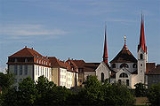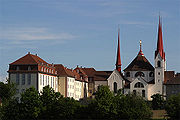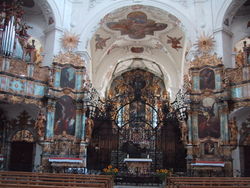
Muri Abbey
Encyclopedia

Martin of Tours
Martin of Tours was a Bishop of Tours whose shrine became a famous stopping-point for pilgrims on the road to Santiago de Compostela. Around his name much legendary material accrued, and he has become one of the most familiar and recognizable Christian saints...
. It flourished for over eight centuries at Muri
Muri
Muri, Formerly known as Muri , is a municipality in southeastern Swiss Canton Aargau and is the capital of same district. The present municipality of Muri was created in 1816 from the merging of the four municipalities Langdorf, Egg, Hasli and Wey....
, in the Canton of Aargau, near Basle in Switzerland
Switzerland
Switzerland name of one of the Swiss cantons. ; ; ; or ), in its full name the Swiss Confederation , is a federal republic consisting of 26 cantons, with Bern as the seat of the federal authorities. The country is situated in Western Europe,Or Central Europe depending on the definition....
. It is currently established as Muri-Gries in South Tyrol
South Tyrol
South Tyrol , also known by its Italian name Alto Adige, is an autonomous province in northern Italy. It is one of the two autonomous provinces that make up the autonomous region of Trentino-Alto Adige/Südtirol. The province has an area of and a total population of more than 500,000 inhabitants...
, formerly a part of the Austrian-Hungarian Empire, now a part of Italy
Italy
Italy , officially the Italian Republic languages]] under the European Charter for Regional or Minority Languages. In each of these, Italy's official name is as follows:;;;;;;;;), is a unitary parliamentary republic in South-Central Europe. To the north it borders France, Switzerland, Austria and...
.
History
The monastery of Saint Martin of ToursMartin of Tours
Martin of Tours was a Bishop of Tours whose shrine became a famous stopping-point for pilgrims on the road to Santiago de Compostela. Around his name much legendary material accrued, and he has become one of the most familiar and recognizable Christian saints...
at Muri in the Canton of Aargau, in the Diocese of Basel (but originally in that of Constance), was founded in 1027 by Radbot, Count of Habsburg
Radbot, Count of Habsburg
Radbot, Count of Habsburg , also known as Radbot of Klettgau, was Graf of the county of Klettgau on the High Rhine in Swabia....
. Rha, a daughter of Frederick, Duke of Lower Lorraine
Frederick, Duke of Lower Lorraine
Frederick of Luxembourg was the count of Malmedy from 1035 and duke of Lower Lorraine from 1046. He was a younger son of Frederick, lord of Gleiberg, and Ermentrude, and grandson of Siegfried, Count of Luxembourg, hence his name....
, and Werner, Bishop of Strasburg, each donated a portion of land to a monastery which they established there. A colony of monks was drawn from the nearby Einsiedeln Abbey
Einsiedeln Abbey
Einsiedeln Abbey is a Benedictine monastery in the town of Einsiedeln in the Canton of Schwyz, Switzerland. The abbey is dedicated to Our Lady of the Hermits, the title being derived from the circumstances of its foundation, from which the name Einsiedeln is also said to have originated...
, under the leadership of Prior Reginbold. On his death in 1055, Burchard was chosen as the monastery's first abbot
Abbot
The word abbot, meaning father, is a title given to the head of a monastery in various traditions, including Christianity. The office may also be given as an honorary title to a clergyman who is not actually the head of a monastery...
. During his rule the abbey church was consecrated in 1064.
About this time, the community was reinforced by the accession of a new colony of monks from the Abbey of St. Blaise in the Black Forest
Black Forest
The Black Forest is a wooded mountain range in Baden-Württemberg, southwestern Germany. It is bordered by the Rhine valley to the west and south. The highest peak is the Feldberg with an elevation of 1,493 metres ....
, one of whom, the Blessed Luitfrid, continued the government of both communities till his death 31 December 1096. The monastery pursued its quiet work of religion and civilization under the leadership of able abbots, the most remarkable of whom were
- Ranzelin
- Cuno, founder of a school and a generous benefactor to the library of the monastery
- Henry Scheuk who greatly increased its landed property
- Henry de Schoenwerd
Under Schoenwerd's rule, a whole family embraced the religious life. The father with his sons entered the abbey of the monks, whilst his wife and daughters betook themselves to the adjoining convent of nuns, a community which later on was transferred to Hermetschwil, a mile or two distant from Muri. The good reputation enjoyed by the Abbey of Muri procured it many friends. In 1114, Emperor Henry V
Henry V, Holy Roman Emperor
Henry V was King of Germany and Holy Roman Emperor , the fourth and last ruler of the Salian dynasty. Henry's reign coincided with the final phase of the great Investiture Controversy, which had pitted pope against emperor...
took it under his special protection; and the Pope
Pope
The Pope is the Bishop of Rome, a position that makes him the leader of the worldwide Catholic Church . In the Catholic Church, the Pope is regarded as the successor of Saint Peter, the Apostle...
s on their side were not less solicitous for its welfare.
The abbey had its vicissitudes of good and bad fortune. It was laid low by two disastrous conflagrations, in 1300 and in 1363; wars and risings checked for a time its prosperity. It recovered something of its old life under Abbot Conrad II, only to suffer again under his successor George Russinger in the war between the Swiss Confederacy
Old Swiss Confederacy
The Old Swiss Confederacy was the precursor of modern-day Switzerland....
and the Habsburgs.
Russinger, who had taken part in the Council of Constance
Council of Constance
The Council of Constance is the 15th ecumenical council recognized by the Roman Catholic Church, held from 1414 to 1418. The council ended the Three-Popes Controversy, by deposing or accepting the resignation of the remaining Papal claimants and electing Pope Martin V.The Council also condemned and...
(1414-1418), set out to reform the abbey and joined it to the newly formed Congregation of Bursfelde, a union of Benedictine monasteries and nunneries founded in 1446 to promote the reform of Benedictine practice. Pope Julius II
Pope Julius II
Pope Julius II , nicknamed "The Fearsome Pope" and "The Warrior Pope" , born Giuliano della Rovere, was Pope from 1503 to 1513...
(1503–1513) granted the abbots of Muri the use of pontificalia.
In the 1530s, the abbey was attacked by troops from Bern, a leading - and newly Protestant - member of the Swiss Confederacy
Old Swiss Confederacy
The Old Swiss Confederacy was the precursor of modern-day Switzerland....
. It survived thanks to abbot Laurentius von Heidegg (1508–1540), who was friends with the Heinrich Bullinger
Heinrich Bullinger
Heinrich Bullinger was a Swiss reformer, the successor of Huldrych Zwingli as head of the Zurich church and pastor at Grossmünster...
, the leading reformer of Zürich
Zürich
Zurich is the largest city in Switzerland and the capital of the canton of Zurich. It is located in central Switzerland at the northwestern tip of Lake Zurich...
.

Swiss Congregation
The Swiss Congregation of the Benedictine Confederation is a grouping of Benedictine monasteries in Switzerland or with significant historical Swiss connections.-Foundation:...
established in 1602. Largely through his efforts discipline was restored; monks of piety and letters went forth from Muri to re-people the half full cloisters; by his wisdom suitable constitutions were drawn up for such communities of nuns as had survived so many revolutions. His successor Dom Dominic Tschudi was a man of like mould, and a scholar whose works were held in great repute. He was born at Baden in 1595 and died there in 1654. His Origo et genealogia comitum do Habsburg is his best known work.
With the eighteenth century fresh honours came to Muri. The Emperor Leopold I
Leopold I, Holy Roman Emperor
| style="float:right;" | Leopold I was a Holy Roman Emperor, King of Hungary and King of Bohemia. A member of the Habsburg family, he was the second son of Emperor Ferdinand III and his first wife, Maria Anna of Spain. His maternal grandparents were Philip III of Spain and Margaret of Austria...
raised Abbot Placid Zurlauben, and his successor, to the rank of princes of the Holy Roman Empire
Holy Roman Empire
The Holy Roman Empire was a realm that existed from 962 to 1806 in Central Europe.It was ruled by the Holy Roman Emperor. Its character changed during the Middle Ages and the Early Modern period, when the power of the emperor gradually weakened in favour of the princes...
, and spent a vast sum of money in rebuilding and embellishing the monastery and church, the ancient mausoleum
Mausoleum
A mausoleum is an external free-standing building constructed as a monument enclosing the interment space or burial chamber of a deceased person or persons. A monument without the interment is a cenotaph. A mausoleum may be considered a type of tomb or the tomb may be considered to be within the...
of the imperial family. The abbey continued to prosper in every way; good discipline was kept up and many distinguished ecclesiastics and learned men were educated within its walls.
With the spread of the French Revolution
French Revolution
The French Revolution , sometimes distinguished as the 'Great French Revolution' , was a period of radical social and political upheaval in France and Europe. The absolute monarchy that had ruled France for centuries collapsed in three years...
, the canton of Aargau set out to drive out religious institutions. Muri, after a long resistance, was obliged to submit. Its abbot, an old man, had withdrawn to the monastery of Engelberg
Engelberg Abbey
Engelberg Abbey is a Benedictine monastery in Engelberg, Canton of Obwalden, Switzerland. It was formerly in the Diocese of Constance, but now in the Diocese of Chur...
, more favourably situated, and there died on 5 November 1838, leaving his successor, D. Adalbert Regli, to deal with the situation after the Canton closed the abbey in 1841. Despite their expulsion from Muri, the community never wholly disbanded; the abbot and some of the monks found a welcome in the Canton of Unterwalden
Unterwalden
Unterwalden is the old name of a forest-canton of the Old Swiss Confederacy in central Switzerland, south of Lake Lucerne, consisting of two valleys or Talschaften, now organized as two half-cantons, an upper part, Obwalden, and a lower part, Nidwalden.Unterwalden was one of the three participants...
, which invited them to undertake the management of the cantonal college at Sarnen
Sarnen
Sarnen is the capital of the canton of Obwalden situated on the shores of Lake Sarnen , Switzerland. It has a population of just under 10,000 and is surrounded by countryside and mountains. Sarnen is located 20 km south of Lucerne.- History :...
. There the main body of the monks resided, until the Austrian Emperor, Ferdinand I
Ferdinand I of Austria
Ferdinand I was Emperor of Austria, President of the German Confederation, King of Hungary and Bohemia , as well as associated dominions from the death of his father, Francis II, Holy Roman Emperor, until his abdication after the Revolutions of 1848.He married Maria Anna of Savoy, the sixth child...
, offered them a residence at Gries near Bozen in Tyrol
County of Tyrol
The County of Tyrol, Princely County from 1504, was a State of the Holy Roman Empire, from 1814 a province of the Austrian Empire and from 1867 a Cisleithanian crown land of Austria-Hungary...
, in an old priory of Augustinian Canons of the Lateran which had been unoccupied since 1807. The Holy See
Holy See
The Holy See is the episcopal jurisdiction of the Catholic Church in Rome, in which its Bishop is commonly known as the Pope. It is the preeminent episcopal see of the Catholic Church, forming the central government of the Church. As such, diplomatically, and in other spheres the Holy See acts and...
concurred in the grant, and confirmed the transfer of the community of Muri to Gries by a Brief of Gregory XVI, dated 16 September 1844. In order to avoid complications the house of Gries was continued in its former status as a priory and incorporated with the Swiss Abbey of Muri, which is regarded as temporarily located in its Austrian dependency, the Abbot of Muri being at the same time Prior of Gries.
The abbey of Muri had been a favoured burial place of the Habsburg dynasty. In the 20th century, the hearts of the last reigning Imperial couple, Emperor Charles I of Austria (1887–1922) and Empress Zita of Bourbon-Parma
Zita of Bourbon-Parma
Princess Zita of Bourbon-Parma was the wife of Emperor Charles of Austria...
(1892–1989) are in the family crypt in the Loretto Chapel, as are the bodies of their sons Rudolf and Felix
Archduke Felix of Austria
Archduke Felix of Austria was the last surviving child of the last Austrian Emperor Charles I and a member of the House of Habsburg-Lorraine...
.

